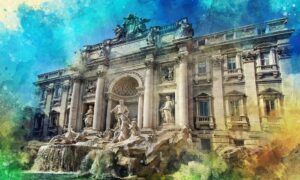The administrative region of Piedmont includes the province of Cuneo, its capital is the city of the same name. Since ancient times, it is believed that St. Michael protects these lands. The city of Cuneo is located on a high plateau, near the river Stura di Demonte. It got its name due to its shape – the city has a wedge-shaped appearance, and translated from Italian Cuneo means “Wedge”.
City history
Cuneo was founded at the end of the 12th century on the interweaving of roads from France to the Piedmont region. At that time, large markets were located here, where agricultural products grown on the adjoining plains were sold. All this area was under the authority of the bishop and some margraviates. However, some people were able to create an independent settlement on Cuneo with their own commune. Thus, an opposition gradually began to form, opposing feudal society. Management in the new commune was built as follows: three people were chosen, one from the people and two from the nobility. But independence did not last long, the Margraviate of Solutso seized the commune in 1210. Twenty years later, the population of Cuneo, with the participation of refugees from Milan and some other cities, revolted. A little later, in 1238, the independence of this city was recognized. In honor of this event, the church of St. Ambrogio was built in Cuneo. However, the city had too many enemies and powerful neighbors, so in 1259 the autonomy and independence ceased again, the commune was captured by Charles of Anjou. After that, power passed into the hands of the Duchy of Savoy. This situation was repeated several times and the power changed several times. In the 20th century, Cuneo became famous for producing a special kind of chocolate, and it was here that the founder of Nutella, Michele Ferrero, was born.
Cuneo Cathedral
The main religious and architectural landmark of the city is the Cathedral of Santa Maria del Bosco, which originally belonged to the abbey of San Dalmazzo di Pedona. The first restoration work was carried out in 1470, from which the baptismal font has been preserved.  The next restoration was carried out in 1560 by the arrival of Emanuele Filiberto, the facade was painted by Pietro Dolce di Savigliano. The current church, built on the site of a previously existing medieval one, dates back to the 17th century, when the ancient building collapsed partially (1656), the restoration was led by the architect Giovenale Boetto di Fossano. From 1684 to 1685 Andrea Pozzo painted an icon for the main altar. In the 18th and 19th centuries, the neoclassical facade and dome were built. In 1860, the statues of San Pietro, San Vincenzo, Santa Teresa by Giuseppe Dini were installed.
The next restoration was carried out in 1560 by the arrival of Emanuele Filiberto, the facade was painted by Pietro Dolce di Savigliano. The current church, built on the site of a previously existing medieval one, dates back to the 17th century, when the ancient building collapsed partially (1656), the restoration was led by the architect Giovenale Boetto di Fossano. From 1684 to 1685 Andrea Pozzo painted an icon for the main altar. In the 18th and 19th centuries, the neoclassical facade and dome were built. In 1860, the statues of San Pietro, San Vincenzo, Santa Teresa by Giuseppe Dini were installed.









